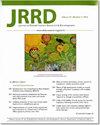Prosthesis management of residual-limb perspiration with subatmospheric vacuum pressure.
Q Medicine
Journal of Rehabilitation Research and Development
Pub Date : 2016-01-01
DOI:10.1682/JRRD.2015.06.0121
引用次数: 8
Abstract
For the ambulatory person with lower-limb amputation, insufficient management of perspiration can result in inadequate prosthesis adherence, reduced mobility, and discomfort. This study compared a dynamic air exchange (DAE) prosthesis designed to expel accumulated perspiration with a total surface bearing suction socket (Suction) that cannot. Five people with unilateral transtibial amputation participated in a randomized, crossover experiment. All subjects were given a 1 wk acclimation to each study prosthesis while we measured their step activity levels. A rest-walk-rest protocol, including a 30 min treadmill walk at a self-selected speed while wearing thermally insulative garments, was then used to observe residual-limb skin temperatures and perspiration. Afterward, subject opinions about the prostheses were assessed with questionnaires. During the week-long acclimation period, no statistical difference in step activity levels were detected between prostheses (p = 0.22), but this may have been due to self-reported behavioral modifications. During the rest-walk-rest protocol, no differences in skin temperatures were observed (p = 0.37). The DAE prosthesis accumulated 1.09 +/- 0.90 g and expelled 0.67 +/- 0.38 g of perspiration, while the Suction prosthesis accumulated 0.97 +/- 0.75 g. The questionnaire results suggest that participants were receptive to both prostheses. The DAE prosthesis was able to expel more than a third of the total perspiration, suggesting it may enable longer uninterrupted periods of perspiration-inducing activity.亚常压真空修复残肢排汗的处理。
对于下肢截肢不能活动的患者,排汗管理不足会导致假体附着不足、活动能力降低和不适。本研究比较了动态空气交换(DAE)假体设计用于排出积汗与全表面承载吸口(吸气)不能排出积汗。五名单侧胫骨截肢患者参加了一项随机交叉实验。所有受试者对每个研究假体进行了1周的适应,同时我们测量了他们的步数活动水平。然后采用休息-步行-休息方案,包括穿着隔热服装以自行选择的速度在跑步机上行走30分钟,观察残肢皮肤温度和排汗。之后,用问卷评估受试者对假体的看法。在为期一周的适应期,假体之间的台阶活动水平没有统计学差异(p = 0.22),但这可能是由于自我报告的行为改变。在休息-行走-休息方案中,没有观察到皮肤温度的差异(p = 0.37)。DAE假体积汗1.09 +/- 0.90 g,排汗0.67 +/- 0.38 g,而吸气假体积汗0.97 +/- 0.75 g。问卷调查结果显示,参与者对两种假肢都能接受。DAE假体能够排出总排汗量的三分之一以上,这表明它可以使不间断的排汗活动持续更长时间。
本文章由计算机程序翻译,如有差异,请以英文原文为准。
求助全文
约1分钟内获得全文
求助全文

 求助内容:
求助内容: 应助结果提醒方式:
应助结果提醒方式:


